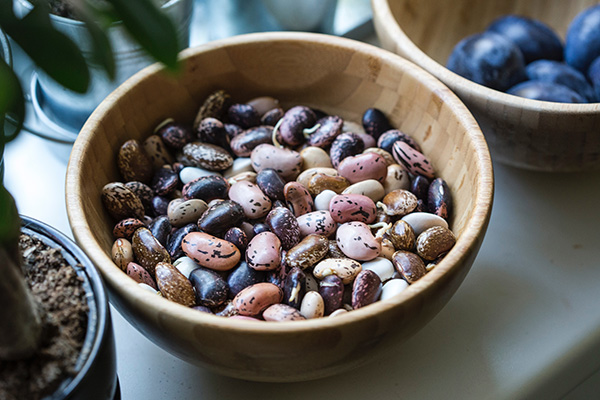2022 marks the JGI’s 25th anniversary. Over the next few months, we’ll be revisiting a number of notable achievements that showcase our collaborations and capabilities to enable great science that will help solve energy and environmental challenges.

The common bean (Phaseolus vulgaris) includes pinto beans, kidney beans, black beans, navy beans and more. (Milada Vigerova)
While a hill of beans may not seem to amount to much, the common bean (Phaseolus vulgaris) is actually a vital source of protein in many food-insecure countries around the globe, as well as a cash crop essential to their economies. It also plays an important role in soil health through nitrogen-fixation and holds clues for maximizing soybean, the common bean’s close relative, as a biofuel.
To this end, a team of researchers led by Jeremy Schmutz of the JGI and the HudsonAlpha Institute for Biotechnology; Phil McClean of North Dakota State University; Dan Rokhsar of the JGI; and Scott Jackson of the University of Georgia sequenced and analyzed the genome of the common bean. That work was published online June 8, 2014 in the journal Nature Genetics.
“Common beans are a major societal crop for those with severely limited income,” McClean said. “Common bean is a very popular food in Central America and Eastern Africa. For smallholder farmers — those with less than two hectares of land — common bean is often a food at every meal.”
McClean cites the common bean’s nutritional value, providing anywhere from 10-30% of daily protein requirements. It is also an essential source of iron and zinc, both of which are particularly important for child growth and development, as well as a vital economic player, as a cash crop for small farmers and a commercial crop for large producers.
The team sequenced and assembled a 473-million basepair genome of the common bean, identifying genes related to disease-resistance, flowering time, nitrogen metabolism, seed weight and domestication. Six races of the common were identified, three from each of the common bean’s two points of origin in Central and South America.
“Technology was actually quite a bit different than it is today,” Schmutz said. “…It was incredibly expensive and time-consuming and involved a lot of different players and researchers across many different labs to be able to sequence a genome.”
Since the paper was published in 2014, it has been cited 1,025 times and the seemingly humble common bean has fueled further research into disease tolerance in crops, drought- and stress-resistance as well as nitrogen fixation; and has enabled discoveries in additional crops such as peanuts, black-eyed peas, soybeans and chickpeas. While no longer under the umbrella of the JGI, McClean and Schmutz have continued their work together unlocking the powers of the bean.
Though the JGI no longer works on food crops specifically, “[At the JGI] we do use Phaseolus as a test model quite frequently for R&D in plant genomics, because it is an inbred dicot,” Schmutz explained, meaning the plant’s reduced genetic diversity makes it easier to genetically manipulate.
One important improvement to the bean spawned from this original research is the “slow-darkening” trait. Traditionally beans have had a shelf-life about roughly 6-9 months before their color begins to darken. Called “after-darkening,” this process not only means the beans take longer to cook, but it also depletes their iron content.
“Cooking time is important if you have to go out and collect wood to cook, not just like walking into your kitchen,” McClean said. “…The less you have to do that, the more positive effect you’re going to have with a faster-cooking bean itself.”
The original reference genome yielded what are now widely-used molecular markers, and slow-darkening has become standard for pinto beans. These beans cook faster, retain their iron content and have a longer shelf-life — up to four years. Work is now underway to transfer the trait into other classes of common beans.
“Beans are beans,” McClean said. “…When you’re trying to make discoveries, you’re going to end up making discoveries across all the different market classes of beans.”
Related links:
- JGI News Release: More Than Just a Hill of Beans
- The original sequence: Nature Genetics
- Phaseolus vulgaris on Phytozome
- Phil McClean presents at the JGI’s 2014 User Meeting
Byline: Allison Joy